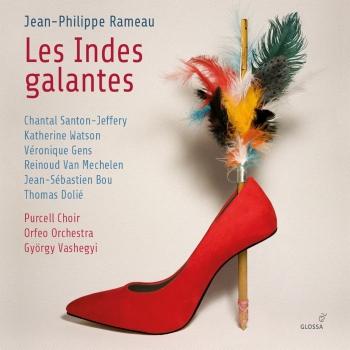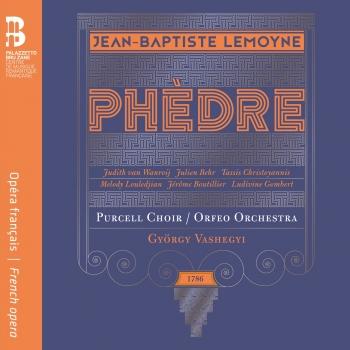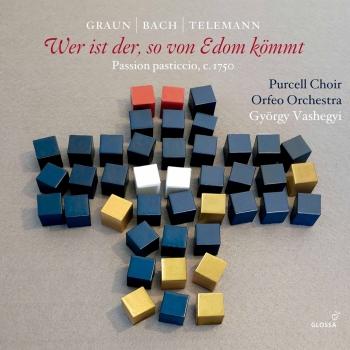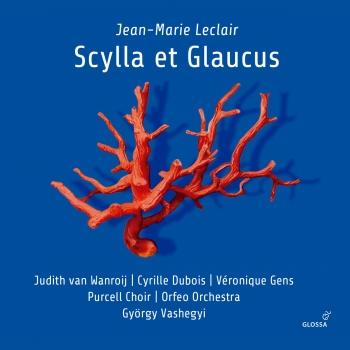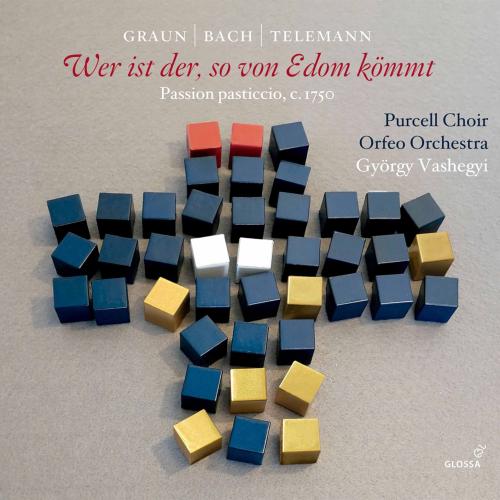
Graun, Telemann & J.S. Bach: Wer ist der, so von Edom kömmt Purcell Choir, Orfeo Orchestra & György Vashegyi
Album info
Album-Release:
2021
HRA-Release:
19.03.2021
Label: Glossa
Genre: Classical
Subgenre: Vocal
Artist: Purcell Choir, Orfeo Orchestra & György Vashegyi
Composer: Georg Philipp Telemann (1681-1767), Carl Heinrich Graun (1703-1759), Johann Sebastian Bach (1685-1750)
Album including Album cover
- Georg Philipp Telemann (1681 - 1767): Wer ist der so von Edom kömmt, Wer ist der so von Sodom kommt, TWV 1:1585:
- 1 Telemann: Wer ist der so von Edom kömmt, Wer ist der so von Sodom kommt, TWV 1:1585: No. 1, Wer ist der so von Edom kömmt 05:05
- 2 Telemann: Wer ist der so von Edom kömmt, Wer ist der so von Sodom kommt, TWV 1:1585: No. 2, Christus, der uns selig macht 00:57
- Carl Heinrich Graun (1707 - 1759): Wer ist der so von Edom kömmt, Ein Lämmlein geht und trägt die Schuld, GraunWV B:VII:4:
- 3 Graun: Wer ist der so von Edom kömmt, Ein Lämmlein geht und trägt die Schuld, GraunWV B:VII:4: No. 3, Fürwahr, er trug unsre Krankheit 02:00
- 4 Graun: Wer ist der so von Edom kömmt, Ein Lämmlein geht und trägt die Schuld, GraunWV B:VII:4: No. 4, So steigt mein Jesus in Geduld 01:14
- 5 Graun: Wer ist der so von Edom kömmt, Ein Lämmlein geht und trägt die Schuld, GraunWV B:VII:4: No. 5, Ihr Tropfen, fallt auf meinen Brust 07:00
- 6 Graun: Wer ist der so von Edom kömmt, Ein Lämmlein geht und trägt die Schuld, GraunWV B:VII:4: No. 6, Ich weiß, was die ihr selbstgelaßene Vernunft 00:49
- 7 Graun: Wer ist der so von Edom kömmt, Ein Lämmlein geht und trägt die Schuld, GraunWV B:VII:4: No. 7, Wir aber hielten ihn für den 01:27
- 8 Graun: Wer ist der so von Edom kömmt, Ein Lämmlein geht und trägt die Schuld, GraunWV B:VII:4: No. 8, Herzliebster Jesu, was hast du verbrochen 00:41
- 9 Graun: Wer ist der so von Edom kömmt, Ein Lämmlein geht und trägt die Schuld, GraunWV B:VII:4: No. 9, Da dich dein Jünger selbst verrät 01:12
- 10 Graun: Wer ist der so von Edom kömmt, Ein Lämmlein geht und trägt die Schuld, GraunWV B:VII:4: No. 10, Was an Strafen ich verschuldet 04:55
- 11 Graun: Wer ist der so von Edom kömmt, Ein Lämmlein geht und trägt die Schuld, GraunWV B:VII:4: No. 11, Er ist um unsrer Missetat willen verwundet 02:56
- 12 Graun: Wer ist der so von Edom kömmt, Ein Lämmlein geht und trägt die Schuld, GraunWV B:VII:4: No. 12, Du trägst die Strafe meiner Schuld 00:57
- 13 Graun: Wer ist der so von Edom kömmt, Ein Lämmlein geht und trägt die Schuld, GraunWV B:VII:4: No. 13, Harte Marter! Schwere Plagen! 06:20
- 14 Graun: Wer ist der so von Edom kömmt, Ein Lämmlein geht und trägt die Schuld, GraunWV B:VII:4: No. 14, Jetzt werd' ich stark durch Christi Leidens-kampf 01:08
- 15 Graun: Wer ist der so von Edom kömmt, Ein Lämmlein geht und trägt die Schuld, GraunWV B:VII:4: No. 15, Nimmst du die Kron der Dornen an 04:46
- 16 Graun: Wer ist der so von Edom kömmt, Ein Lämmlein geht und trägt die Schuld, GraunWV B:VII:4: No. 16, Ja, ja, es geh' mir wie es will 00:55
- 17 Graun: Wer ist der so von Edom kömmt, Ein Lämmlein geht und trägt die Schuld, GraunWV B:VII:4: No. 17, Er war der Allerverachtetste und Unwerteste 02:11
- 18 Graun: Wer ist der so von Edom kömmt, Ein Lämmlein geht und trägt die Schuld, GraunWV B:VII:4: No. 18, O Haupt voll Blut und Wunden 01:22
- Johann Sebastian Bach (1685 - 1750): Wer ist der so von Edom kömmt, Herr Jesu Christ, wahr' Mensch und Gott, BWV 127:
- 19 Bach: Wer ist der so von Edom kömmt, Herr Jesu Christ, wahr' Mensch und Gott, BWV 127: No. 19, Herr Jesu Christ, wahr' Mensch und Gott 05:32
- 20 Bach: Wer ist der so von Edom kömmt, so heb ich denn mein Auge sehnlich auf, BWV 1088: No. 20, So heb ich denn mein Augesehnlich auf 01:58
- Carl Heinrich Graun: Wer ist der so von Edom kömmt, Ein Lämmlein geht und trägt die Schuld, GraunWV B:VII:4:
- 21 Graun: Wer ist der so von Edom kömmt, Ein Lämmlein geht und trägt die Schuld, GraunWV B:VII:4: No. 21, Sollt' ich nicht auf Jesum sehn 07:32
- 22 Graun: Wer ist der so von Edom kömmt, Ein Lämmlein geht und trägt die Schuld, GraunWV B:VII:4: No. 22, Die Macht, so meinen Heiland leiden läßt 00:47
- 23 Graun: Wer ist der so von Edom kömmt, Ein Lämmlein geht und trägt die Schuld, GraunWV B:VII:4: No. 23, Hier steht der Grund von meinem Glauben 04:27
- Anonymous:
- 24 Wer ist der so von Edom kömmt: No. 24, In der ersten Tagestund 00:57
- Carl Heinrich Graun: Wer ist der so von Edom kömmt, Ein Lämmlein geht und trägt die Schuld, GraunWV B:VII:4:
- 25 Graun: Wer ist der so von Edom kömmt, Ein Lämmlein geht und trägt die Schuld, GraunWV B:VII:4: No. 25, Der ungerechte Richter selbst 00:34
- 26 Graun: Wer ist der so von Edom kömmt, Ein Lämmlein geht und trägt die Schuld, GraunWV B:VII:4: No. 26, Arme Seel'! Zerschlagnes Herz! 05:46
- Anonymous:
- 27 Wer ist der so von Edom kömmt: No. 27, Um sechs ward er nackt und bloß 01:00
- Carl Heinrich Graun: Wer ist der so von Edom kömmt, Ein Lämmlein geht und trägt die Schuld, GraunWV B:VII:4:
- 28 Graun: Wer ist der so von Edom kömmt, Ein Lämmlein geht und trägt die Schuld, GraunWV B:VII:4: No. 28, Ja, ja, mein Heiland geht die Todes-Bahn 00:24
- 29 Graun: Wer ist der so von Edom kömmt, Ein Lämmlein geht und trägt die Schuld, GraunWV B:VII:4: No. 29, Ich lose mit, mein köstlich'st Theil 04:20
- Anonymous:
- 30 Wer ist der so von Edom kömmt: No. 30, Jesus schrie' zur neunten Stund' 01:01
- Carl Heinrich Graun: Wer ist der so von Edom kömmt, Ein Lämmlein geht und trägt die Schuld, GraunWV B:VII:4:
- 31 Graun: Wer ist der so von Edom kömmt, Ein Lämmlein geht und trägt die Schuld, GraunWV B:VII:4: No. 31, Ich sehe meinen Jesum ganz verlassen 01:42
- 32 Graun: Wer ist der so von Edom kömmt, Ein Lämmlein geht und trägt die Schuld, GraunWV B:VII:4: No. 32, Mich entseelt ein banger Schrekken! 05:47
- 33 Graun: Wer ist der so von Edom kömmt, Ein Lämmlein geht und trägt die Schuld, GraunWV B:VII:4: No. 33, Jedoch mein Glaube stärkt sich wiede 00:28
- 34 Graun: Wer ist der so von Edom kömmt, Ein Lämmlein geht und trägt die Schuld, GraunWV B:VII:4: No. 34, Christus hat mit einem Opfer 02:49
- 35 Graun: Wer ist der so von Edom kömmt, Ein Lämmlein geht und trägt die Schuld, GraunWV B:VII:4: No. 35, Nun darf ich mich denn nicht entsetzen 06:14
- 36 Graun: Wer ist der so von Edom kömmt, Ein Lämmlein geht und trägt die Schuld, GraunWV B:VII:4: No. 36, Ist Jesus Tod! 00:38
- 37 Graun: Wer ist der so von Edom kömmt, Ein Lämmlein geht und trägt die Schuld, GraunWV B:VII:4: No. 37, Zerbrich nun Macht und Pracht der Erden 04:30
- Anonymous:
- 38 Wer ist der so von Edom kömmt: No. 38, Da man hat zur Vesperzeit 01:03
- Johann Sebastian Bach: Wer ist der so von Edom kömmt:
- 39 Bach: Wer ist der so von Edom kömmt: No. 39, Der Gerechte kömmt um 05:58
- Anonymous:
- 40 Wer ist der so von Edom kömmt: No. 40, Da der Tag sein Ende nahm 01:15
- Carl Heinrich Graun: Wer ist der so von Edom kömmt, Ein Lämmlein geht und trägt die Schuld, GraunWV B:VII:4:
- 41 Graun: Wer ist der so von Edom kömmt, Ein Lämmlein geht und trägt die Schuld, GraunWV B:VII:4: No. 41, Zu meinem Heill, zur Glaubensstärke 01:53
- Anonymous:
- 42 Wer ist der so von Edom kömmt: No. 42, O hilf Christe, Gottes Sohn 01:08
Info for Graun, Telemann & J.S. Bach: Wer ist der, so von Edom kömmt
The conductor György Vashegyi and his ensembles, the Orfeo Orchestra and the Purcell Choir, are fluent in various fields of baroque and classical music, with a particular predilection for French baroque opera. But one of their favourite lines of work is Lutheran sacred music, and a good example of this is this beautiful work, Wer ist der, so von Edom kömmt (“Who is this that comes from Edom?”), a period pasticcio with pieces by various composers. Graun (a composer at the court of Frederick II who was greatly admired by his contemporary colleagues), rubs shoulders here with Telemann and Johann Sebastian Bach, as well as with a mysterious unknown, who wrote several of the most impressive passages in the work. In fact, this is a Passion Oratorio, a reflection on the events related to the martyrdom of Christ based on freely chosen texts without following a precise Gospel and without summoning the usual characters of the drama into an imaginary setting. The originality of this patchwork also lies in the distribution of the text where – contrary to many passions of the time – the events of the last days of Jesus’ life are told by chorales that float in the meditative atmosphere of the recitatives, arias and choruses. These chorales are especially impressive in the second part: the density of the writing, the unique dramatic harmonies, the arrangement of the voices are of such an exceptional quality that their author could definitely be Johann Sebastian Bach himself... whom the author of the essay included in the libretto, Gergely Fazekas, also points to as the possible compiler of this masterpiece.
Agnes Kovacs, soprano
Peter Barany, counter-tenor
Zoltan Megyesi, tenor
Lorant Najbauer, bass
Purcell Choir
Orfeo Orchestra
György Vashegyi, conductor
Purcell Choir
The Purcell Choir was founded in 1990 in Budapest by György Vashegyi for the performance of Purcell’s Baroque opera Dido & Aeneas. Few suspected at the time that the group would become the most respected choir in Hungary fifteen years later. All of the choir members are excellent professional singers, musicians and instrumentalists, and some of them are also members of other choirs and orchestras. The core repertoire of the Purcell Choir ranges from works by Gesualdo to Mozart, but the ensemble also performs works by more modern composers. The Purcell Choir is a regular participant at the Haydn Festivals in Hungary; for example, the choir performed with the Capella Savaria Ensemble in 2004, conducted by Nicholas McGegan. The Purcell Choir and the Orfeo Orchestra are closely connected as performing partners and together they have taken part in a large number of TV, CD and concert recordings in Hungary.
Orfeo Orchestra
The Orfeo Orchestra was founded in Budapest in 1991 by György Vashegyi, taking its name from Monteverdi’s L’Orfeo, after the ensemble presented the first complete performance of this opera in Hungary. The orchestra consists of professional musicians with experience in Hungary as well as on the international scene, either as members of the orchestra or as instrumental soloists. The Orfeo Orchestra is the most authentic exponent of classical music in Hungary and it has given many first performances on period instruments under the baton of György Vashegyi. Between 2002 and 2007 the ensemble performed the first eighty symphonies composed by Haydn as part of Mr. Vashegyi’s own concert series (at Esterházy Palace), enabling these to be heard there for the first time since the 18th century with the same number of musicians, on period instruments, as Haydn himself used to perform them. The names of the Orfeo Orchestra and the Purcell Choir have now become inseparably linked with that of Mr. Vashegyi, who can rightly be described as the outstanding exponent of classical and early music in Hungary and the person who has revitalized these works this country.
György Vashegyi
was born in Budapest in 1970 and began his musical studies as an instrumentalist: he played the violin, flauto dolce, the oboe and the harpsichord. At just 18 he became a student of conducting under Ervin Lukács at the Ferenc Liszt Academy of Music in Budapest, obtaining his diploma with distinction in 1993. He was a frequent participant in the conducting master classes of John Eliot Gardiner and Helmuth Rilling and from 1994 to 1997 he was a student in the continuo master class of John Toll in Dresden, where he also studied chamber music with Jaap ter Linden and Simon Standage. He has performed as a continuo player in leading Hungarian chamber orchestras such as the Ferenc Liszt Chamber Orchestra and Concerto Armonico. In 1990 he founded the Purcell Choir in Budapest and one year later the Orfeo Orchestra. In 1991 Vashegyi made his operatic debut with Gluck’s Orfeo together with the Budapest Chamber Opera. He undertook successful tours with Orfeo in France, Switzerland and Luxembourg. In his concerts (mostly in Budapest) he has conducted many important works of the 17–18th centuries which until then had never been performed in Hungary, including Buxtehude’s Membra Jesu Nostri, Purcell’s The Fairy Queen, Funeral Anthem and Theodora by Handel, and the Requiem by Kraus. Nevertheless, he primary emphasis is on the research and performance of 18th century works by Hungarian composers which are still unknown internationally. He works primarily with his own ensembles but also gives concerts with other early music groups, including Concerto Armonico, Capella Savaria and Musica Aeterna, as well as with modern symphony orchestras and chamber orchestras as a guest conductor. He made his debut at the Hungarian State Opera of Budapest (with the Orfeo Orchestra) in August 2000 with Haydn’s L’infedeltà delusa; this was the first opera performance with period instruments in the history of the Hungarian State Opera. Since 2001 he has conducted regularly at the State Opera. In 2004 he conducted the Prague Chamber Orchestra in Würzburg (at the Mozart Fest) and Kloster Eberbach (at the Rheingau Festival).
This album contains no booklet.















